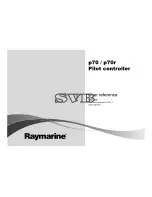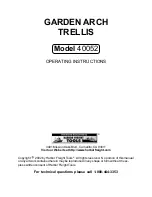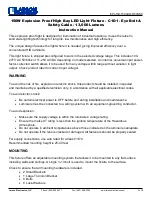
2
from the smallest nearfield limit in to the transducer level the pressure
level will be constant.
If the source level of the echo sounder is not known, but both beamwidths
or transducer array lengths or even just area are, the maximum possible
pressure level may still to a good degree be estimated. Then one has to
rely upon the fact that there is a maximum acoustic power intensity that
can be applied to a transducer in the order of 2-5 W/cm
2
to avoid cavitation
(lowest number is typical at say 12 kHz, highest at say 100 kHz). With
shading being applied in one direction the power will be reduced to about
50-60%, and for both directions to about 30%.
The calculations outlined above are for the on-axis direction (usually
straight down). Off-axis the pressure level will fall rapidly for a narrow
beam (alongtrack for a multibeam echo sounder), the level will be 20 dB
down at a little more than twice the beamwidth. Acrosstrack, the pressure
level will typically be 20 dB down for angles of more than 75-80° of the
vertical for flat arrays. At for example 45° the closest nearfield distance
will be half that of on-axis, leading to a 3 dB reduction in pressure level for
distances larger than the nearfield distance on-axis. At 60° the nearfield
distance will be reduced by another factor of two, and taking into account
the usual level reduction at large beam angles also, the pressure level
would typically be down about 8 dB compared to on-axis. At 70° the level
will be about 16 dB down due a further halving of the nearfield distance
and the beam pattern drop-off. For multibeams which use sectorized
transmission such as most current Kongsberg systems, beam defocusing is
applied in the central sector(s) in shallow waters which implies that the
nearfield will be shortened and the drop-off in pressure level starts earlier.
For curved transducers the nearfield limit and the pressure level will stay
fairly constant across the whole angular coverage angle.
Sonars may be transmitting horizontally and with a sound speed profile
where the sound speed lessens toward the surface the spreading will
cylindrical even in the farfield due to ducting causing a sound channel at
the surface. For multibeam echo sounders this is usually not the case,
except for tilted systems such as with the dual head EM 3002.
The following table shows the relevant parameters for the currently
available Kongsberg multibeam echo sounders. For each model the
alongtrack (transmit) beamwidth, the source level in dB re 1
μ
Pa at 1
meter, calculated nearfield distances and pressure levels in dB re 1
μ
Pa at
the nearfield distances are provided. The effect of absorption loss is not
included in this table.





















